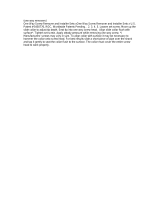
PAGE 13 TP10289-2
SUREWASH
10.0 MATERIAL SAFETY DATA
SHEET
NOTICE: Surewash is a product of RBP Chemical
Corporation, 150 S. 118th St., P.O. Box 14069, Milwaukee,
Wisconsin 53214-0069. Tel. 414/258-0911, 800/558-0747.
irritation and may affect central nervous system. May cause
skin irritation. Chronic over-exposure to many petroleum
hydrocarbons may cause liver or kidney injury. May cause
eye irritation.
Emergency & First Aid Prodedures:
Skin Contact: Wash affected area with soap and water.
Remove contaminated clothing.
Eye contact: Flush eyes with water for at least 15
minutes. Consult a physician.
Inhalation: Remove to fresh air. Restore breathing if
required. Get medical attention.
Ingestion: DO NOT induce vomiting. Get medical
attention.
Carcinogenicity: None of the ingredients in this prod-
uct are listed by IARC, NTP, or OSHA as carcinogenic.
Signs and Symptoms of Over-exposure: Headache,
dizziness, nausea, irritation of the mucous membranes, res-
piratory tract irritation or mild narcosis at high concentra-
tions.
Medical Conditions Aggravated by Exposure: May
aggravate an existing dermatitis.
PRECAUTIONS FOR USE AND DISPOSAL
Spills: Small spills can be soaked up with suitable
absorbent. For large spills, dike the spill and pump to salvage
tank.
Waste Disposal: Incineration or absorbent disposal
according to local, state, or federal regulations.
Special Storage/Handling Precautions: None
CONTROL MEASURES
Respiratory Protection: Organic vapor respirator for
concentrations above the TLV.
Ventilation: Mechanical
Eye Protection: Recommended
Gloves: Recommended, butyl, rubber or neoprene.
Other: Eye bath or safety shower should be located in
the work place when working with chemicals.
*ND = No data found or not determined.
The information contained herein is furnished without
warranty of any kind. Users should consider this data a
supplement to other information gathered by them and are
responsible for completeness of information to assure proper
use of these materials and the safety and health of their
employees.
H M I S RATING
Health: 1
Flammability: 2
Reactivity: 0
Personal Protection: 8
HAZARDOUS INGREDIENTS
Name: Medium Aliphatic Solvent Naptha
(Syn: 140 HF Mineral Spirits)
CAS#: 64742-88-7
ACGIH TLV: 100ppm
OSHA PEL: 500ppm
%: <95
PHYSICAL/CHEMICAL CHARACTERISTICS
Boiling Point: ND
Solubility in Water: Insoluble
% Volatiles (by vol.): 95
Specific Gravity: 0.786
Appearance and Odor: Clear, light blue liquid
with pleasant odor.
FIRE AND EXPLOSION HAZARD DATA
Flash Point: 140' F
Extinguishing Media: CO2, Dry chemical,
Foam
Special Fire Fighting Procedures: Wear self-
contained breathing apparatus for any fire
involving chemicals.
Unusual Fire and Explosion Hazards: None
REACTIVITY DATA
Stability: Stable
Incompatibility: Strong oxidizers
Hazardous Decomposition By-products: Car-
bon dioxide/monoxide
Hazardous Polymerization: Will not occur
Conditions to Avoid: Heat, Sparks, and Open
Flames
HEALTH HAZARD DATA
Routes of Entry: Inhalation, Primary; Skin,
Secondary; Ingestion, Unlikely
Health Hazards Acute and Chronic: Chronic Inhala-
tion of high concentrations may cause respiratory tract
To order Surewash call toll free, 800/543-6107
Part numbers: 24108-001 (quart) & 24108-002 (gal-
lon)














